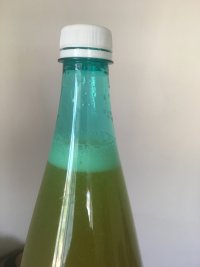sancupanza
Member
Hello guys,
Very new here and to the world of brewing, just registered. Quick question, already read many threads but could not find the answer to my problem.
I just brewed my first ever whole-grain batch (5 gallons) in a disastrous process but the result (initial taste) was surprisingly not bad prior to bottling.
When I opened the lid of the fermenter, the heavy alcohol smell was encouraging since I was aiming for a Belgian blonde but when I saw some small islands of whitish organisms floating, I was a bit worried.
Didn’t know what to do with it so in a panic decided to add a flat teaspoon of potassium metabisulfite (hope it’s not sorbate, since I got it unlabeled from a winery nearby) and waited overnight.
Next morning tasted the batch and it’s taste had significantly changed to worse but still not so bad. Again in a panic, I prepared some priming sugar with a new pack of yeast and pitched half an hour before bottling.
My question: Bottles are not carbonating. What shall I do? Even my pear cider (without PMS) is carbonating but not my beer.
Shall I put everything back into the fermenter and pitch a new pack of yeast with some priming sugar?
I know I should not get emotionally attached to this batch but it’s my first try and I want to drink it carbonated
Thanks in advance!
Very new here and to the world of brewing, just registered. Quick question, already read many threads but could not find the answer to my problem.
I just brewed my first ever whole-grain batch (5 gallons) in a disastrous process but the result (initial taste) was surprisingly not bad prior to bottling.
When I opened the lid of the fermenter, the heavy alcohol smell was encouraging since I was aiming for a Belgian blonde but when I saw some small islands of whitish organisms floating, I was a bit worried.
Didn’t know what to do with it so in a panic decided to add a flat teaspoon of potassium metabisulfite (hope it’s not sorbate, since I got it unlabeled from a winery nearby) and waited overnight.
Next morning tasted the batch and it’s taste had significantly changed to worse but still not so bad. Again in a panic, I prepared some priming sugar with a new pack of yeast and pitched half an hour before bottling.
My question: Bottles are not carbonating. What shall I do? Even my pear cider (without PMS) is carbonating but not my beer.
Shall I put everything back into the fermenter and pitch a new pack of yeast with some priming sugar?
I know I should not get emotionally attached to this batch but it’s my first try and I want to drink it carbonated
Thanks in advance!










































![Craft A Brew - Safale S-04 Dry Yeast - Fermentis - English Ale Dry Yeast - For English and American Ales and Hard Apple Ciders - Ingredients for Home Brewing - Beer Making Supplies - [1 Pack]](https://m.media-amazon.com/images/I/41fVGNh6JfL._SL500_.jpg)















